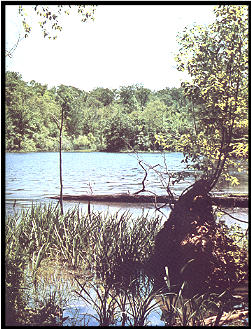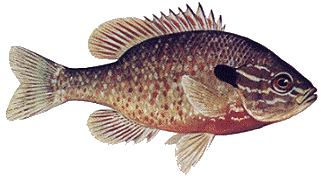SUMMER
As spring turns to summer, the days get longer, hotter and
more humid, and the fish change their daily routine. They spend
the hottest parts of the day in deeper, cooler water or in the shade
of submerged weedbeds, and then move into shallow water in late
afternoons and evenings to feed. If it is really hot, that movement
can be relatively slow, and often the sction doesn't pick up until
8 or 9pm. During these times fish stay in shallow water only as long
as the temperatures are relatively moderate, which may be only an
hour or so.
To be successful during midsummer, try fishing early in the morning
where weeds and grass grow in shallow water. Start with a size 10 or size
12 McGinty or Black Gnat wet fly to locate fish quickly. Always
approach the spot by getting into the water a good distance away and moving
as slowly and as quietly as possible to avoid disturbing the fish. Begin
casting from a good distance and don't get any closer to the area the fish
are using than is necessary.
If you happen to be on the lake during one of those infrequent cooler
summer days that sometimes occur after a long period of scorchers, try using
a size 12 or size 14 Adams Irresistible dry fly. Cast it as close to cover or
vegetatopm as possible to imitate an insect that has fallen from the weeds
and is floating in the water. Depending on the weather conditions you may
have fast-paced bluegill fishing for an hour or so, or the action may last
only a few minutes. It's in your best interest to play the percentages -
when you catch one fish from an area, continue to fish there. Bluegill like
company, so when you catch one fish from a particular spot, odds are
there are others where that one came from.
There is a small cove on the east side of Pawnee Lake, just a
few minutes drive from Lincoln, Nebraska, that is fairly shallow,
and has abundant weed growth along the entire shoreline. The
slender trunk of a long-dead tree protrudes from the water in the
middle of the cove, maybe 10 to 12 yards from shore. My son Jim
and I found the cove early one summer morning and thought it
looked like a good bluegill spot. We experimented with several fly
patterns, tried fishing several spots around the cove and enjoyed
catching a few fish. Then Jim cast a weighted size 10 Improved McGinty
wet fly at the tree trunk. Jim is a pretty accurate caster, and the fly
landed just inches from the spot where the tree sticks out of the water.
The fly slowly sank below the surface and a couple of seconds later
BANG! He had a fish. It was a good-sized bluegill and gave Jim a
spirited tussel before he finally landed it.

He put the fish in his basket, cast at the tree again and caught another
bluegill. After he had landed his fifth or sixth fish on nearly as many
casts, I decided to try that spot too, and started casting to the tree
from the opposite side of the cove.
If my cast landed within a few inches of the tree I could nearly
count on a strike, but if I missed the mark and my fly landed more than
a couple of feet away, nothing happened.
We took several more fish from that spot, and then decided to
try another place on the lake we always like to fish. We returned to that
cove several more times during summer and fall that year, and always
caught fish, though the action never matched the fishing we found that
first morning. Sometimes the dead tree would hold fish; sometimes we'd
find them near vegetation along the shoreline, sometimes they were in an
emergent weedbed off the cove's north shore. They weren't always in
exactly the same spot, but we always found them somewhere in the
small cove.
We fished that small cove many times in the following 4 or 5
years until Jim enrolled in college in another state. I've located other
good bluegill fishing spots and haven't returned to that cove since the
last time Jim and I fished it. One day when our schedules allow a
fishing trip or two, we'll fish it again and I'm sure we'll find plenty
of hungry bluegill waiting, probably in the same spots we fished
years ago. ~ Tom Keith
More SUMMER next time!
|



